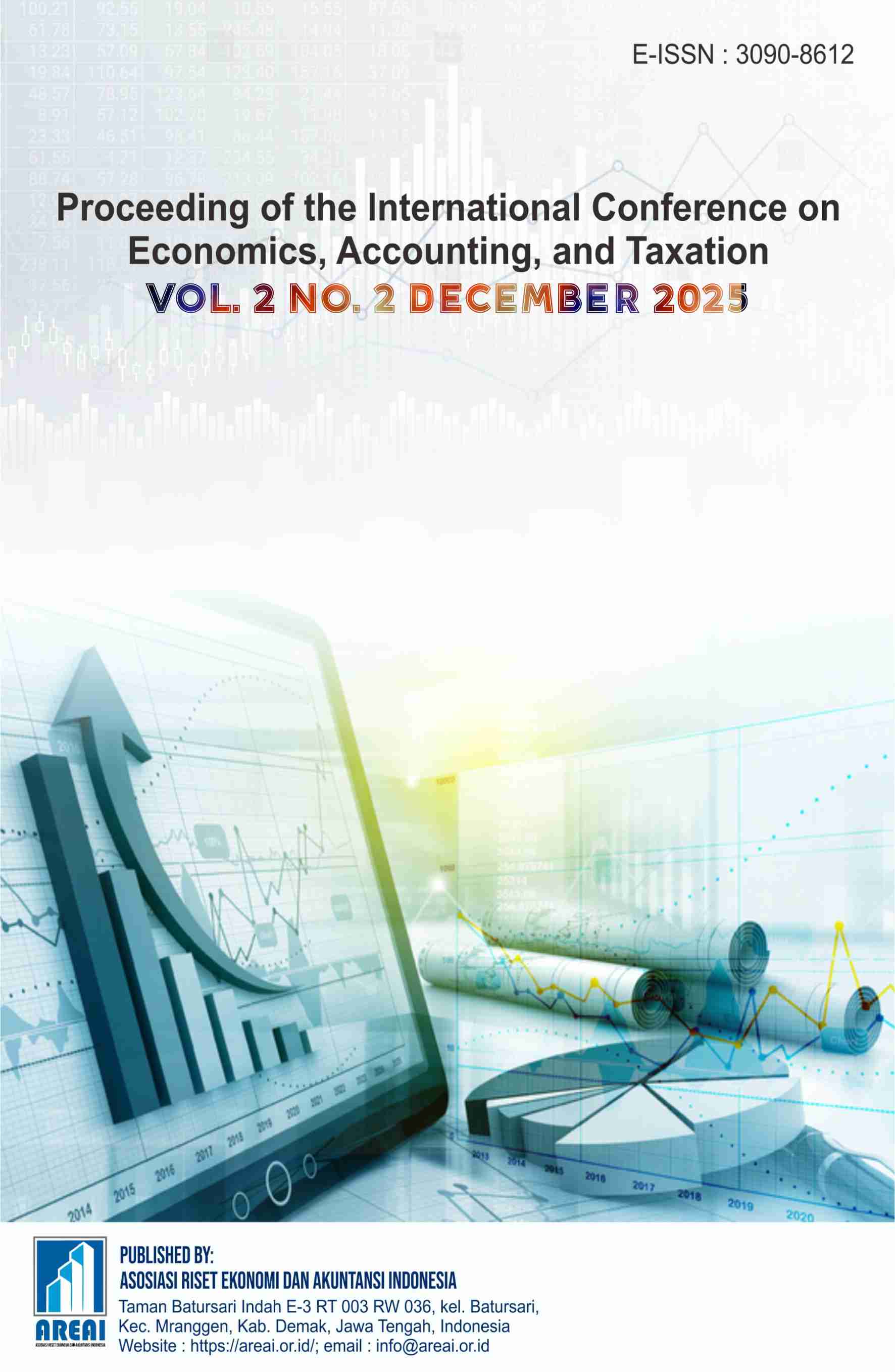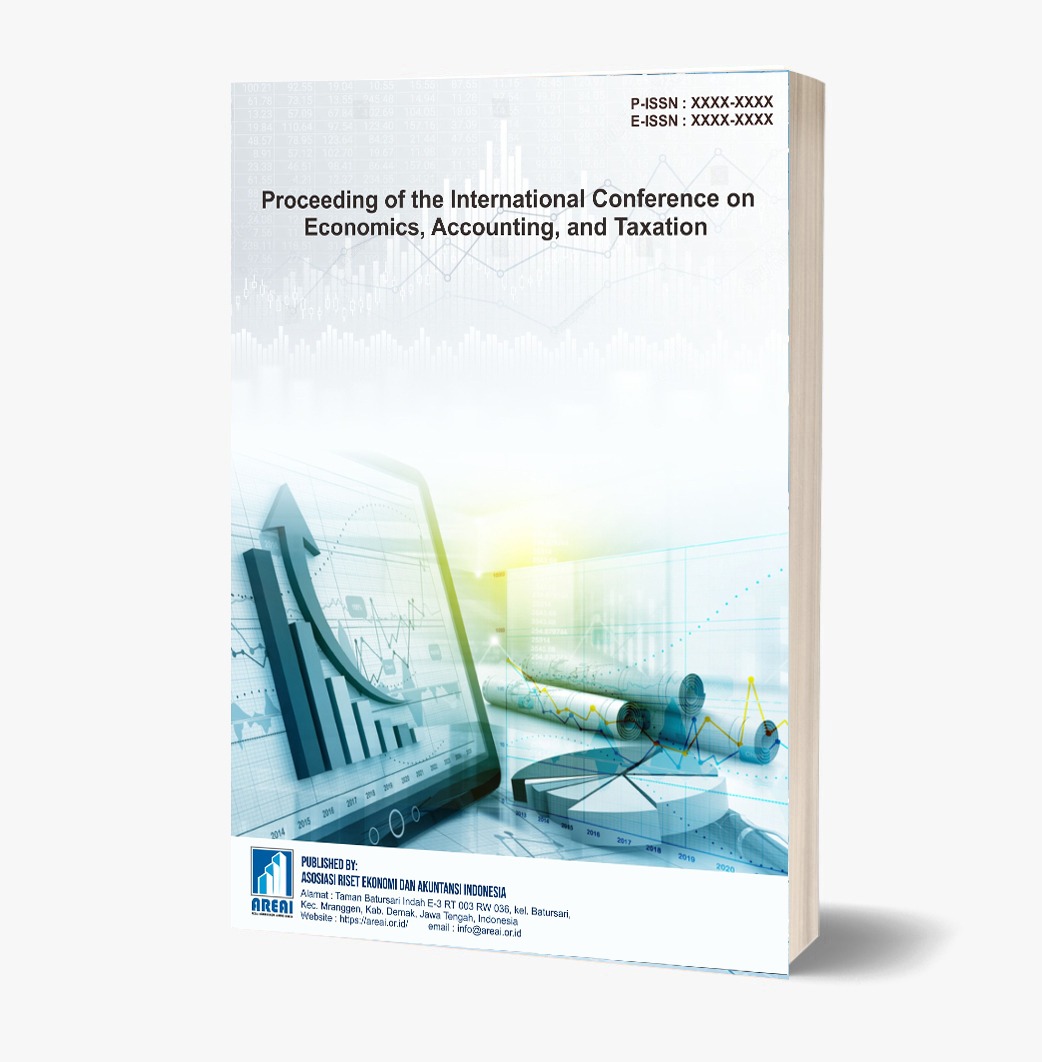Analysis of Exports, Imports, Exchange Rates, and Inflation on Economic Growth in 5 ASEAN Countries
DOI:
https://doi.org/10.61132/iceat.v2i2.132Keywords:
ASEAN Countries, Economic Growth , Exchange Rates, Exports, ImportsAbstract
This study uses a quantitative associative approach to analyze the influence of exports, imports, inflation, and exchange rates on economic growth in five ASEAN member countries: Indonesia, Malaysia, Singapore, Thailand, and Vietnam. The data used are secondary data obtained from the World Bank for the period 2013–2023. The analysis technique used is the Panel Autoregressive Distributed Lag (Panel ARDL) Model, which begins with stationarity and cointegration tests. Results The ARDL Panel Model estimation in this study is declared valid because it meets the main requirements, namely having a cointegrated lag with a negative coefficient value of -0.831550 and significant at the 5% significance level (probability 0.0000 < 0.05). The long-term estimation results indicate that only the inflation variable has a significant influence on Gross Domestic Product (GDP) in the 5 ASEAN countries studied. Meanwhile, in the short term, no variables were found to have a significant influence on GDP in the 5 countries. Furthermore, country-level estimations show varying results. Indonesia is the only country that shows a significant influence of exports, imports, inflation, and exchange rates on GDP. Thailand shows a significant influence of exports and exchange rates, while Malaysia, Singapore, and Vietnam do not show any significant influence of exports, imports, inflation, and exchange rates on GDP. These findings reflect that the relationship between macroeconomic variables and economic growth in ASEAN countries is heterogeneous and is strongly influenced by the structural characteristics of each country.
Downloads
References
Ambarwati, A. D., Sara, I. M., & Aziz, I. S. A. (2021). The effect of money supply (JUB), BI rate, and inflation on economic growth in Indonesia 2009-2018. Warmadewa Economic Development Journal (WEDJ), 4(1), 21-27. https://doi.org/10.22225/wedj.4.1.3144.21-27
Andiarto, T. (2019). Analysis of the influence of exports, imports, foreign investment, rupiah exchange rate, and foreign exchange reserves on economic growth in Indonesia for the period 1999-2018 (Doctoral dissertation, Muhammadiyah University of Surakarta).
Andi, T., Adib, S., Mufti, A., Miftah, A., & Ika, P. (2023). The impact of COVID-19 on the economy in Singapore. e-Journal of Economic Appreciation, 11(1), 1-12.
Brancaccio, E., & Saraceno, F. (2017). Evolutions and contradictions in mainstream macroeconomics: The case of Olivier Blanchard. Review of Political Economy, 29(3), 345-359. https://doi.org/10.1080/09538259.2017.1330378
Cahyani, F. N. (2021). Analysis of the influence of exports, imports, inflation, and exchange rates on economic growth in Indonesia in the period 2002-2019 (Doctoral dissertation, Muhammadiyah University of Surakarta).
Fahmi, I. (2019). Fundamentals of the Indonesian economy. PT Raja Grafindo Persada.
Falianty, T. A. (2020). Macroeconomic theory and its application in Indonesia. Depok: Rajawali Pers.
Gujarati, D. N. (2012). Basic econometrics (Translated edition). Jakarta: Erlangga.
Hodijah, S., & Angelina, G. P. (2021). Analysis of the impact of exports and imports on economic growth in Indonesia. Journal of Applied Management and Finance, 10(01), 53-62. https://doi.org/10.22437/jmk.v10i01.12512
Krugman, P. R., & Obstfeld, M. (2018). International economics: Theory and policy. Pearson Education.
Lubis, N. H., & Syarvina, W. (2023). Analysis of the effect of exchange rates and inflation on economic growth in Indonesia. Al-Istimrar: Journal of Islamic Economics, 2(2), 150-162. https://doi.org/10.59342/istimrar.v1i2.393
Mankiw, N. G. (2021). Principles of economics. Cengage Learning.
Masloman, I. (2018). Analysis of economic growth and potential sectors and competitiveness in South Minahasa Regency. Scientific Periodical Journal of Efficiency, 18(01).
Meilaniwati, H., & Tannia, T. (2021). Analysis of the influence of foreign direct investment (FDI), domestic direct investment (DDI), trade openness (TO), and inflation on economic growth in ASEAN-5 2009-2018. Business Management Journal, 17(1), 89-100. https://doi.org/10.30813/bmj.v17i1.2582
Mulya, D. H. (2019). The influence of exports, imports, consumption, and inflation on economic growth in 5 ASEAN countries (Doctoral dissertation, Islamic University of Indonesia).
Nasution, L. N. (2018). Analysis of consumption, exports, and agriculture on economic growth in North Sumatra. Journal of Economic Studies and Public Policy (JEpa), 3(2), 82-86.
Nauli, C., Maramis, M. T. B., & Mandeij, D. (2024). Analysis of the influence of net exports and currency exchange rates on economic growth in the ASEAN region for the period 2012-2021. Scientific Periodical Journal of Efficiency, 24(2), 109-120.
Prawoto, N. (2019). Introduction to macroeconomics. Depok: Rajawali Pers.
Putong, I. (2015). Macroeconomics: An introduction to macroeconomics (Vol. 1). Books & Articles by Iskandar Putong.
Putra, R. C. Y., & Soebagiyo, D. (2023). Analysis of the influence of inflation, currency exchange rates, and GDP on economic growth in 5 ASEAN countries 2007-2022. Journal of Business and Management, 3(4), 561-565.
Putri, R. R. N. B. (2022). Analysis of the impact of exports on economic growth in ASEAN countries.
Putri, S. Y. D. (2023). Analysis of the effect of inflation, exports, imports, foreign direct investment (FDI), and exchange rates on ASEAN-10 gross domestic product (GDP) for the 2012-2021 period (Doctoral dissertation, Islamic University of Indonesia).
Rahajeng, R. P. (2022). Analysis of the effect of exports, imports, policy interest rates, and inflation on economic growth in 5 ASEAN countries in 2010-2020. Thesis: University of Lampung.
Rahmawati, W. (2022). Analysis of factors influencing foreign direct investment (FDI) on economic growth in Indonesia 2000-2019. Profit: Journal of Management, Business and Accounting, 1(4), 60-77. https://doi.org/10.58192/profit.v1i4.193
Rangkuty, D. M., & Nasution, L. N. (2018). Analysis of inflation and imports in Indonesia. Jurnal Ekonomikawan, 18(2), 455671. https://doi.org/10.30596/ekonomikawan.v18i2.2552
Rangkuty, D. M., Nasution, L. N., & Ramadhani, A. E. (2020). Analysis of macroeconomic variables on economic growth in Indonesia. Journal of Economic Studies and Public Policy (JEpa), 5(1), 78-85.
Rusiadi, R. H., & Subiantoro, N. (2017). Research methods in management, accounting, and development economics (Concepts, cases, and applications of SPSS, Eviews, Amos, Lisres). Medan: USU Press.
Saradewa, Z., Sunarti, S., & Maulana, I. (2018). The influence of cultural and political differences on the dynamics of competition for economic power between Australia and China in the Asia Pacific region. Journal of Asia Pacific Studies, 2(1), 59-70. https://doi.org/10.33541/japs.v2i1.672
Sari, M., Hanum, S., & Rahmayati. (2022). Risk management analysis in the implementation of good corporate governance: A study of banking companies in Indonesia. Muhammadiyah University of North Sumatra.
Sugiyono. (2019). Quantitative, qualitative and R & D research methods. Bandung: Alphabet.
Suseno, & Astiyah, S. (2010). Inflation. Bank Indonesia: Jakarta.
Susilowati, I. H., & Rosento, R. (2020). Forecasting the IDR exchange rate against the USD using the moving average and exponential smoothing methods. Jurnal Perspektif, 18(1), 91-98.
Syahputra, R. (2017). Analysis of factors influencing economic growth in Indonesia. Samudra Ekonomika Journal, 1(2), 183-191.
Syarifuddin, F. (2016). Indonesia's exchange rate policy response, Bank Indonesia. Jakarta: BI Institute.
Wulandari, D., & Laut, L. T. (2022). Analysis of the relationship between exports, imports, and JUB to inflation in Indonesia in 2015-2019. Development Economics Bulletin, 3(2). https://doi.org/10.21107/bep.v3i2.18397
World Bank. (n.d.). The World Bank. Retrieved from http://www.worldbank.org
Wikipedia. (n.d.). List of ASEAN countries by GDP. Retrieved from https://en.wikipedia.org/wiki/List_of_ASEAN_countries_by_GDP
Downloads
Published
How to Cite
Issue
Section
License
Copyright (c) 2025 Proceeding of the International Conference on Economics, Accounting, and Taxation

This work is licensed under a Creative Commons Attribution-ShareAlike 4.0 International License.






